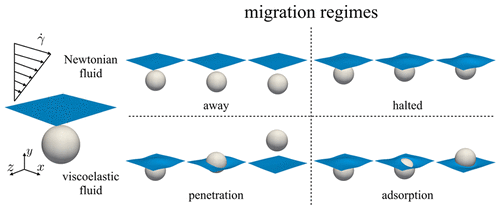Our official English website, www.x-mol.net, welcomes your feedback! (Note: you will need to create a separate account there.)
Shear-Induced Migration of Rigid Particles near an Interface between a Newtonian and a Viscoelastic Fluid
Langmuir ( IF 3.9 ) Pub Date : 2018-01-17 00:00:00 , DOI: 10.1021/acs.langmuir.7b03482 Nick. O. Jaensson 1, 2 , Christos Mitrias 1 , Martien A. Hulsen 1 , Patrick D. Anderson 1
Langmuir ( IF 3.9 ) Pub Date : 2018-01-17 00:00:00 , DOI: 10.1021/acs.langmuir.7b03482 Nick. O. Jaensson 1, 2 , Christos Mitrias 1 , Martien A. Hulsen 1 , Patrick D. Anderson 1
Affiliation

|
Simulations of rigid particles suspended in two-phase shear flow are presented, where one of the suspending fluids is viscoelastic, whereas the other is Newtonian. The Cahn–Hilliard diffuse-interface model is employed for the fluid–fluid interface, which can naturally describe the interactions between the particle and the interface (e.g., particle adsorption). It is shown that particles can migrate across streamlines of the base flow, which is due to the surface tension of the fluid–fluid interface and a difference in normal stresses between the two fluids. The particle is initially located in the viscoelastic fluid, and its migration is investigated in terms of the Weissenberg number Wi (shear rate times relaxation time) and capillary number Ca (viscous stress over capillary stress). Four regimes of particle migration are observed, which can roughly be described by migration away from the interface for Wi = 0, halted migration toward the interface for low Wi and low Ca, particle adsorption at the interface for high Wi and low Ca, and penetration into the Newtonian fluid for high Wi and high Ca. It is found that the angular velocity of the particle plays a large role in determining the final location of the particle, especially for high Wi. From morphology plots, it is deduced that the different dynamics can be described well by considering a balance in the first-normal stress difference and Laplace pressure. However, it is shown that other parameters, such as the equilibrium contact angle and diffusion of the fluid, are also important in determining the final location of the particle.
中文翻译:

牛顿和粘弹性流体之间界面附近的刚性颗粒的剪切诱导迁移
提出了在两相剪切流中悬浮的刚性颗粒的模拟,其中一种悬浮液是粘弹性的,而另一种是牛顿的。Cahn-Hilliard扩散界面模型用于流体-流体界面,它可以自然地描述粒子与界面之间的相互作用(例如,粒子吸附)。结果表明,由于流体-流体界面的表面张力以及两种流体之间的法向应力不同,颗粒可以跨基本流线迁移。粒子最初位于粘弹性流体中,并根据魏森伯格数Wi(剪切速率乘以弛豫时间)和毛细管数Ca对其迁移进行了研究。(粘滞应力超过毛细血管应力)。颗粒迁移的四个制度中观察到,这大致可以通过迁移远离该接口描述无线= 0,停止迁移朝向为低的界面无线和低的Ca,颗粒吸附在高的界面无线和低的Ca,和渗透成高的牛顿流体无线和高的Ca。发现粒子的角速度在确定粒子的最终位置方面起着很大的作用,特别是对于高Wi。从形态图可以推断,通过考虑第一法向应力差和拉普拉斯压力之间的平衡,可以很好地描述不同的动力学。然而,已经表明,其他参数,例如平衡接触角和流体的扩散,在确定粒子的最终位置时也很重要。
更新日期:2018-01-17
中文翻译:

牛顿和粘弹性流体之间界面附近的刚性颗粒的剪切诱导迁移
提出了在两相剪切流中悬浮的刚性颗粒的模拟,其中一种悬浮液是粘弹性的,而另一种是牛顿的。Cahn-Hilliard扩散界面模型用于流体-流体界面,它可以自然地描述粒子与界面之间的相互作用(例如,粒子吸附)。结果表明,由于流体-流体界面的表面张力以及两种流体之间的法向应力不同,颗粒可以跨基本流线迁移。粒子最初位于粘弹性流体中,并根据魏森伯格数Wi(剪切速率乘以弛豫时间)和毛细管数Ca对其迁移进行了研究。(粘滞应力超过毛细血管应力)。颗粒迁移的四个制度中观察到,这大致可以通过迁移远离该接口描述无线= 0,停止迁移朝向为低的界面无线和低的Ca,颗粒吸附在高的界面无线和低的Ca,和渗透成高的牛顿流体无线和高的Ca。发现粒子的角速度在确定粒子的最终位置方面起着很大的作用,特别是对于高Wi。从形态图可以推断,通过考虑第一法向应力差和拉普拉斯压力之间的平衡,可以很好地描述不同的动力学。然而,已经表明,其他参数,例如平衡接触角和流体的扩散,在确定粒子的最终位置时也很重要。



























 京公网安备 11010802027423号
京公网安备 11010802027423号